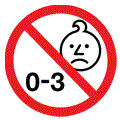Keep cot toys, cot bumpers and cot nests out of your baby’s cot, the Lullaby Trust’s advice is that ‘the safest cot is a clear cot’. This reduces the risk of head-covering and other accidents.
Noisy toys such as cap guns can damage hearing. Don’t allow children to hold them near their own or anyone else’s ears.
Slimes and putties can cause irritation, diarrhoea, vomiting and cramps due to an excess use of boron in the ingredients. Don’t let your child play with slimes and putties on their own.
Kites should not be used near overhead power lines. If a kite gets caught, the electricity can travel down the cord and cause serious injury.
Laser pointers can be powerful enough to damage central vision if shone into a child’s eye. There’s no way of knowing how strong a laser pointer is, so keep them away from children at all times.
Make sure garden toys such as swings or climbing frames are not easily toppled over. Use them over soft grass or soil and make sure there are no hard edges, spikes or glass where children might fall. Regularly check fastenings and ropes for looseness and wear. Be aware of the risk of slips and trips on artificial grass when it gets wet too. Ensure any trampolines are fitted with safety netting. Your child should be supervised at all times when outside.

Be mindful of hot tubs and paddling pools because of the risk of chemicals and drowning. Paddling pools must be emptied after use and put away. Babies can drown in as little as 5cm (2″) of water – this depth can easily collect in an empty paddling pool left out in the rain. Learn more about reducing the risks of drowning here.
Keep plastic bags and nappy sacks away from under fives. Tie any carrier bags up and keep them out of sight and reach. Plastic sheets that seal and protect many new toys, products and appliances, especially large ones, can also present a risk if they’re not thrown away immediately.





